NOTE: Due to recent storms, the camera broadcast is out of order. We think the problem may be with the camera way up in the tree next to the nest, rather than with the rest of the broadcast equipment that we recently examined, so it is unlikely that we will be able to fix it until after the nesting season. The nest and the adults appear to be fine, and therefore we hope and expect that the chicks are OK as well.
2024-2025 SNAPSHOTS

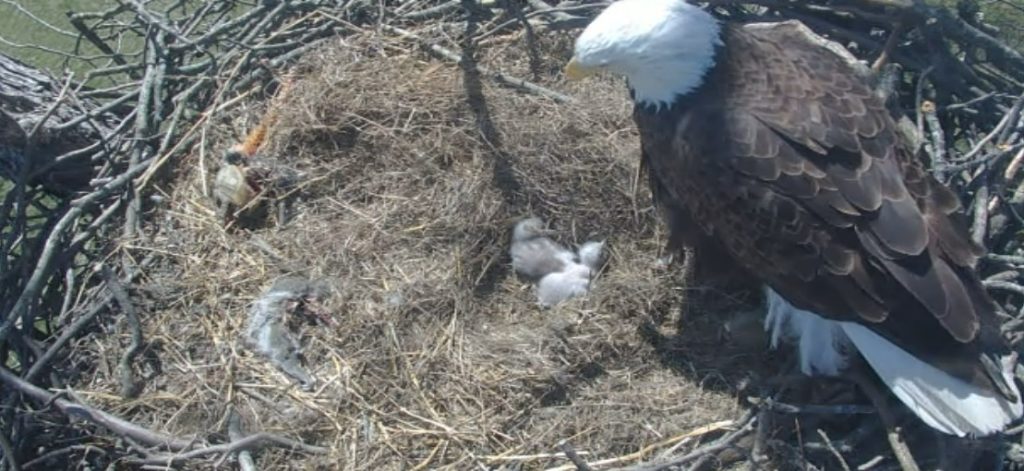
24 March 2025: The second chick hatched this morning!

21 March 2025: It’s hatch day!

19 March 2025, morning: Still two eggs. If the eggs are fertile, we expect one to hatch this week.

23 February 2025: One egg has broken. It appears that some of the yolk is visible on the remaining eggs. This month we celebrated the appearance of three eggs in our local bald eagle nest. They appeared to survive the cold weather, and we had high hopes of three young chicks hatching this season. This week, eagle cam viewers noticed that one egg was missing. After reviewing the footage, we can verify that on the morning of February 23rd one egg suffered a catastrophic structural loss. It cracked. When we see a broken egg, it is hard not to be reminded of thinning eggshells that decimated populations of many birds of prey, including our bald eagles, prior to the increased regulation of DDT as a commercially available pesticide. This case, however, seems to be a natural occurrence and something that is known to occasionally happen, even in healthy populations. We will continue to monitor the health of the nest and have high hopes for a successful hatch of the surviving eggs in the next few weeks.
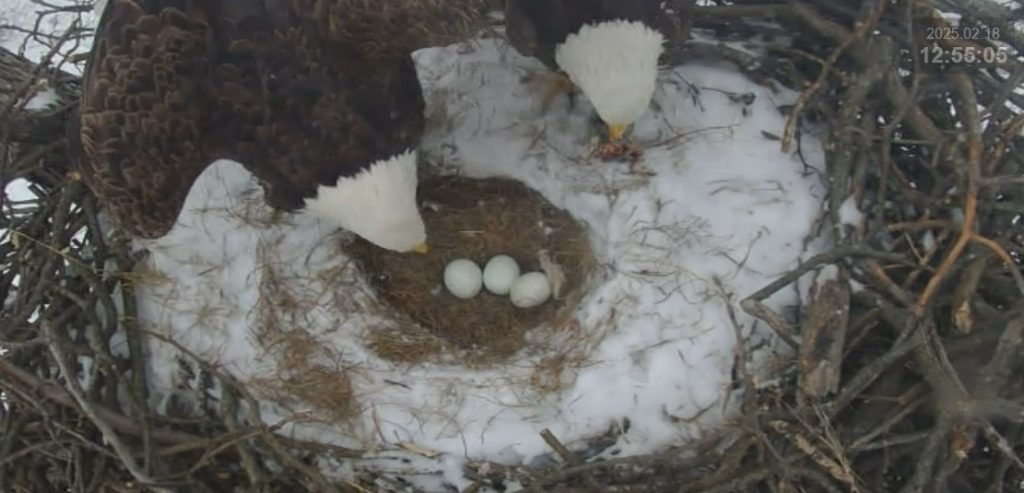
18 February 2025: Bitterly cold temperatures and snow are part of the routine for nesting eagles. The pair continues incubating three eggs despite nighttime temperatures expected to go below zero degrees F this week.

17 February 2025: Three eggs now in the nest!

13 February 2025: A second egg in the nest!

13 February 2025: Incubating in the snow!

10 February 2025: The first egg of this season for our camera pair! And a meadowlark has been brought in as prey.

31 October 2024: The eagle pair is occasionally spending time in the nest, well ahead of their usual egg laying season.
2023-2024 SNAPSHOTS











Click for Bald Eagle Nesting Information
2023 Eagle Cam Time Lapses
25 May 2023: A morning of preening and stretching their wings before breakfast is delivered! You will notice that the eaglets are standing at the edge of the nest more often and spreading their wings, building up muscles for that first flight!
17 May 2023: My, how they’ve grown! At six weeks old, the eaglets are beginning to stand and walk more freely around the nest. Parents are still feeding them, but soon they will begin to tear pieces of food off for themselves and give mom and dad a bit of a break.
1 May 2023: The entire family was at the nest this morning. The sleepy eaglets are growing rapidly and as you can see, it is getting a bit crowded!
24 April 2023: The bald eagle chicks have better thermoregulation now, and they can be left alone more often. Their gray natal down is slowly being replaced with a first set of dark brown feathers. This period of rapid growth and development will continue for another 6 weeks or so!
6 April 2023: SURPRISE!!! We are happy to see that the last egg has hatched! Time will tell if this little one catches up with its older sibling, but we are hoping for the best and there is plenty of food in the nest at the moment!
5 April 2023: We will be surprised if the remaining egg hatches at this point, and one chick went missing the night before last. But the remaining chick appears to be doing well with both parents feeding and tending to it. Wishing this chick the best!
4 April 2023: Two hungry chicks
4 April 2023: There are now two eaglets! Although it has been a weekend with a lot of commotion including wind, wildfires, and smoke, it was time to hatch!
1 March 2023: The third egg being laid!
23 February 2023: The first egg being laid!
1 February 2023: The eagles were working late into the evening.
Nest updates for 2023 nesting season at Bartlesville nest
23 May 2023: Thanks to regular meals, such as this one of fish, the eaglets are nearing full size and are well on their way to reaching independence.
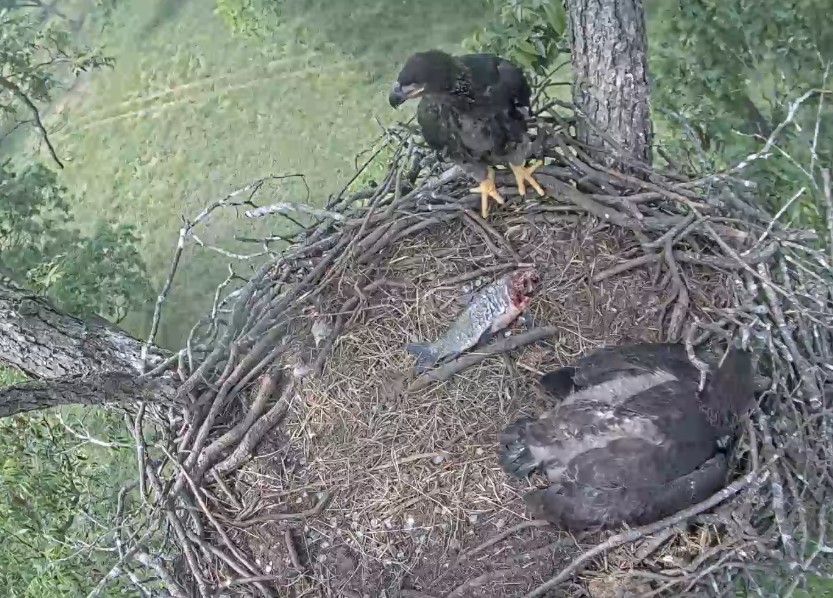
3 April 2023: One chick has hatched, and a second looks to be about halfway out of the egg at 8:00 this morning!

28 March 2023: The first egg is pipped! We are all watching for the chick to emerge!

1 March 2023: A third egg is present in the nest today (it was laid yesterday afternoon)! In the photo below, one eagle has just left to take a break from incubating the eggs, and the other is about to take a turn at incubating.

27 February 2023: A second egg was laid last Saturday afternoon. Will a third arrive on Tuesday?
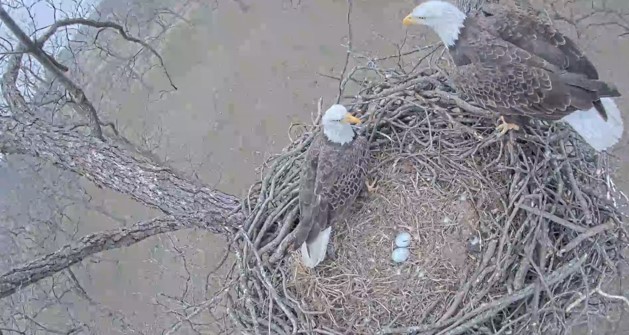
22 February 2023: The first egg was laid this afternoon!


24 January 2023: One of the pair brought prey back to the nest to eat this afternoon. In the lower photo, one eagle moves a stick while the other is eating.


20 January 2023: The eagles have been refurbishing the nest over the past few months, which is a good indication that they might choose to use this nest again this season. Last year, they laid their first egg in February, which is later than many eagle pairs in Oklahoma begin laying. Here are a few photos from the nest camera, and of one of the pair soaring high above the nest.



2022 Eagle Cam Time Lapse Video
Nest updates for 2022 nesting season at Bartlesville nest
6 June 2022: The eaglets have begun “branching,” in which they fly a very short distance to a nearby branch for periods of time before returning to the nest. This process usually goes on for some time as they learn how to fly.

26 May 2022: Regular viewers have noticed that the chicks are often left alone for longer periods now compared to when they were younger. As they approach adult size and have grown their first set of feathers, they are able to regulate their body temperature even during the chilly, rainy weather seen at the nest this week. They can also feed themselves from prey dropped off at the nest by the adults. Essentially, they are becoming “teenagers” now and are somewhat more independent. They also exercise their wings regularly to start preparing for their first flights in a few weeks.

10 May 2022: The chicks continue to grow in size and replace their gray down with brown juvenile feathers. These development processes will continue for the next 5-6 weeks that they will remain at the nest. They have become capable of feeding themselves, although they are still fed by an adult as well. Pictured below is one eaglet (the older and larger one) that grabbed a fish dropped off by an adult, and turned its back to the other chick in order to keep the fish for itself (first photo below). A short while later, an adult returned with another fish that was grabbed by the other chick (second photo below).


28 April 2022: Feeding time for the two chicks this morning. They are beginning to replace their gray down feathers with brown juvenile feathers as they continue to grow in size.

15 April 2022: Unfortunately, last weekend, the youngest chick did not survive, and was observed being covered with nest lining materials by an adult. This failure of the youngest chick to survive is not uncommon with three-chick broods. It can be hard to compete for food with two older and larger siblings. The older two chicks are doing well and growing rapidly. Here, they seem to be gazing out from the rim of the nest.

8 April 2022: Afternoon nap!

7 April 2022: All three chicks are in a huddle, surrounded by a smorgasbord of fish and turtles that have been provided to the nest today! Good hunting!

4 April 2022: The size difference between the last chick to hatch and its older siblings is really apparent, but so far, it is hanging in there and is active.

31 March 2022: Surprise, surprise! A third chick hatched today! Time will tell whether it can get enough food and survive with its two older and larger siblings dominating the feeding sessions, but sometimes eagles can raise three chicks. About half of the last eggshell remains in the nest in the photo below.

30 March 2022: The two chicks being fed this afternoon. In one photo, one of the chicks looks up towards the camera while the other is being fed.


27 March 2022: A Canada Goose made a close fly-by of the nest, causing the eagle to adopt a defensive posture!
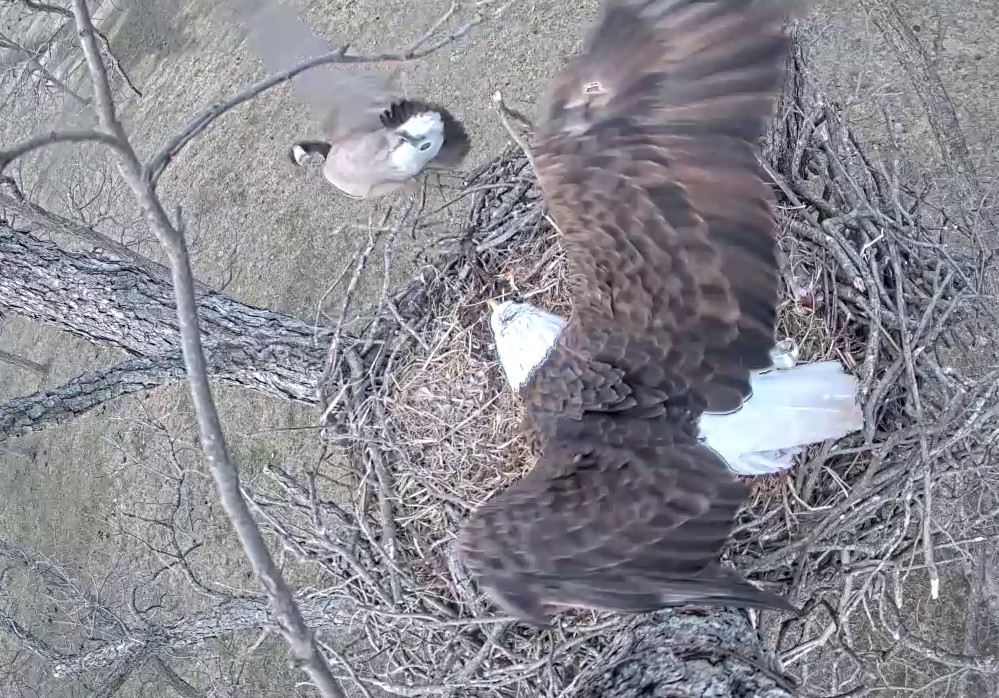
Two chicks are receiving breakfast this morning!
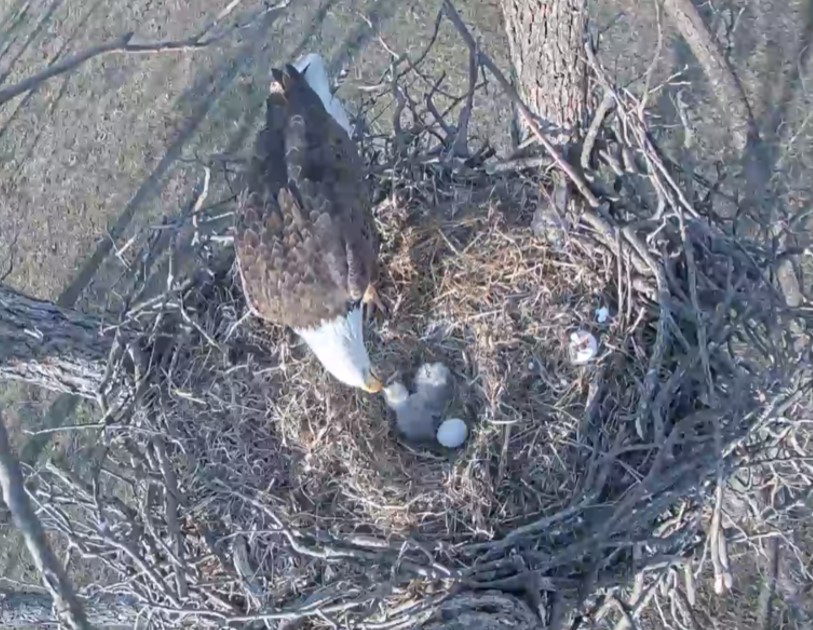
25 March 2022: Persistent and careful incubation and brooding often makes it difficult to see the eggs and any young chicks, but there is a fluffy gray eaglet in the nest! It opens its bill wide for a meal in the first photo below.


24 March 2022: With three eggs still present, it looks as though the first egg may have been infertile, or did not survive. Because eagles begin incubation with the first egg, the other eggs would be expected to hatch at roughly the same interval apart as when they were laid. Join us in hoping and watching for a chick over the coming days!
21 March 2022: Still incubating three eggs, but look for the first egg to hatch between now and Wednesday!
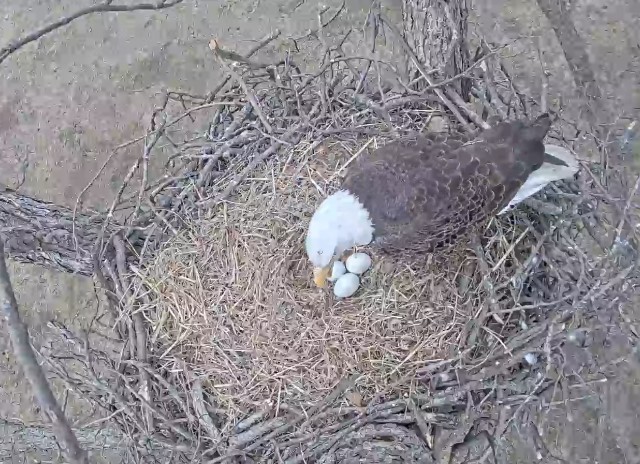
14 March 2022: The eagle takes a short break to rotate the eggs. The timing between egg rotations varies, but is often about 30 minutes. The first egg should hatch next week.

24 February: While we didn’t catch when the third egg was laid, three eggs are now being incubated, a task that looks uncomfortable in the sleet!

18 February: A second egg was laid today! Two eggs is a common clutch size for Bald Eagles, so this might be the end of egg laying, but a third egg is possible. Be watching Monday or Tuesday for that possibility. In the meantime, incubation will continue for the two eggs.

16 February 2022: Shown below is the pair with their egg, and a switch, where the female (who incubates the most) leaves for a short break and the male takes over. Most eagle pairs lay more than one egg, so we might expect to see another egg laid on Friday or Saturday.


15 February 2022 (Bartlesville): An egg was laid early this afternoon!

9 February 2022 (Bartlesville): An eagle comes in for a landing, and then eyes the sky, before making additional adjustments to the grassy nest lining.


7 February 2022 (Bartlesville): After sitting in a nicely formed nest bowl for a while, the eagle leaves. Will there be an egg soon?

28 January 2022 (Bartlesville): The eagles have moved a “cow pie” into the nest. We have seen this behavior once before on a previous nest elsewhere in Oklahoma. Why? Good question!

27 January 2022 (Bartlesville): One adult leaves the nest after both participated in some minor adjustments to the sticks and the grass nest lining.

25 January 2022 (Bartlesville): The nest has been lined with grass, and some adjustments made to the sticks, which are indications that the nest might be used by the pair this season.

1 December 2021 (Bartlesville): Both adults visiting the nest either as preparation for using the nest this season, or as part of the process of determining which of their nests they will use this season.

1 October 2021 (Bartlesville): The pair has recently been seen courting and is pictured here together at the nest that they used last year.
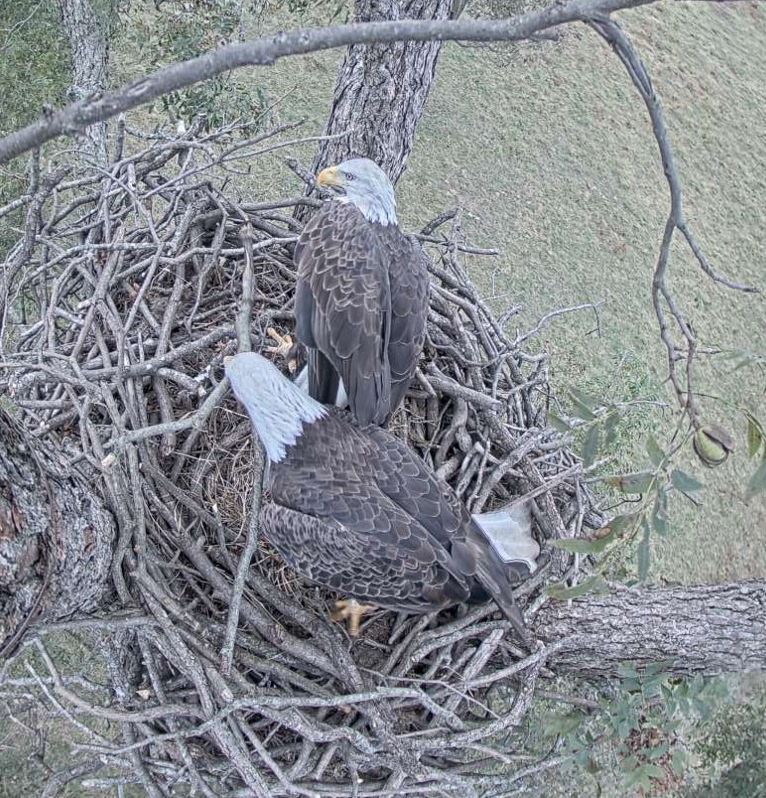
Nest updates for 2021
8 December 2020 (Sequoyah): This nighttime photo from December 3 that was sent in by a viewer shows an eagle roosting at the nest.

24 November 2020 (both nest sites): This is the annual wait-and-see if the eagles will use the same nests as last year. We hope so, but there is never a guarantee that they won’t choose an alternate nest site.
26 October 2020 (Sequoyah): The camera was hit by lightning some time ago, causing an outage. We recently replaced the camera and the cable to restore the view. The nest tree is now dead, so we don’t know how long it will remain before it falls, or if the eagles will return to use the nest this year after their failure last year, but we can be watching!

Nest updates for 2020:
29 April 2020: A late afternoon nap in the sun for this raccoon.

26 March 2020: The raccoons are still present.
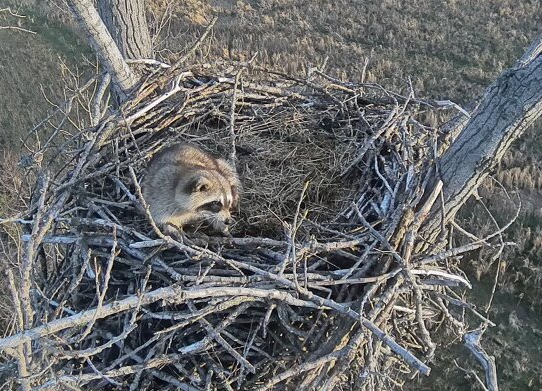
21 March 2020: A new resident has moved in to the eagle nest. Is the eagle pair puzzled? Perturbed? This sequence of photos was taken in two sessions a couple of hours apart. First of the raccoon basking in the sun in mid-afternoon, and later the eagle inspecting the new hole in the bottom of the nest, as well as the raccoon partially emerging from the hole.

5 March 2020: Both adults visited the nest near sunset, prior to roosting for the night.

1 March 2020: Both adults roosting at the nest tonight.

24 February 2020: One eagle roosted in the nest tonight.

17 February 2020: A prey item that appeared to be an American Coot was taken to the nest and eaten this afternoon.

14 February 2020: Since our last update on the 10th, the remaining egg was incubated less and less, and has essentially been abandoned at this point. It is still early enough in the nesting season that it could be removed by the eagles and a new clutch laid, although after a nest failure such as this, a re-nesting attempt may be more likely to take place at an alternate nest site in their territory rather than at the site of the failure. If the eagles do move to another nest site, there is always the possibility of something else trying to move into the nest, as we saw in February of 2013 when a Great Horned Owl attempted to nest here after the eagles failed. The photo below is from this nest in 2013 when the owl laid 2 eggs alongside an eagle egg that had failed to hatch.

10 February 2020: Our last comment about it being “interesting to see what happens” proved prophetic! Life in the wild is never dull, even if the act of incubating eggs for over a month looks sedate most of the time. Shortly after 4 PM on Saturday, the incubating eagle was attacked by an intruding eagle. Less than a hour later, there was a second attack. The intruder was apparently repelled both times, but at the cost of one egg, which had significant damage, and was eaten about 25 hours later by the adult on Sunday evening. Many species of birds from the size of hummingbirds on up face similar attempts by rivals to take over territories and prime nesting sites. While we all are cheering for a successful nest, our camera shows what really happens each day at a wild eagle nest, both the good and the bad. We can’t say at this point whether or not the remaining egg is viable. Because we suspect this is a new male since last season, it is possible that the eggs were infertile (not uncommon in eagles and other birds), or the remaining egg may have been damaged in the attack. We won’t have to wait very long to find out. If the egg is going to hatch, it should happen later this week. Here are some photos from the Saturday attacks, and the next days.
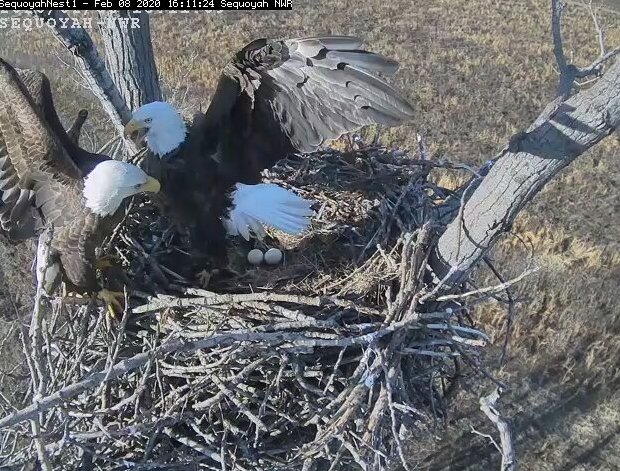

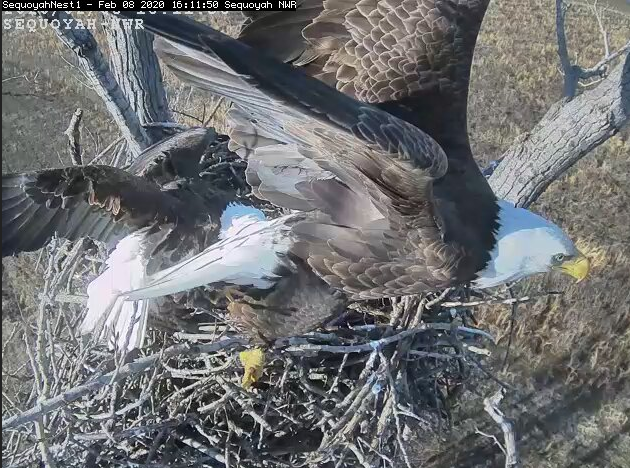





7 February 2020: The first picture below shows adjustments being made to the nest lining. Still two eggs, and based on the laying date, the hatch timing is more likely to be later this weekend rather than today. A number of people have commented on how infrequently the mate returns to the nest. We are gearing up for three major projects this spring, and have had limited time to watch the nest this year, but we agree that the pattern of visitation by the mate this season is very infrequent compared to previous years at this nest, when he often returned almost hourly. This likely indicates that something happened to the original male between last nesting season and this season, and the female has a new partner this year. There can be significant differences in attentiveness and other behaviors among individual birds. As always, it will be interesting to see what happens!

Feeding Time!
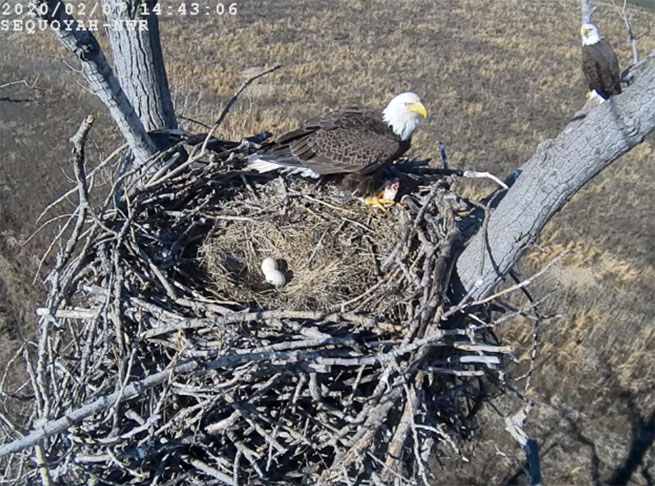
Coming back for incubation duty!
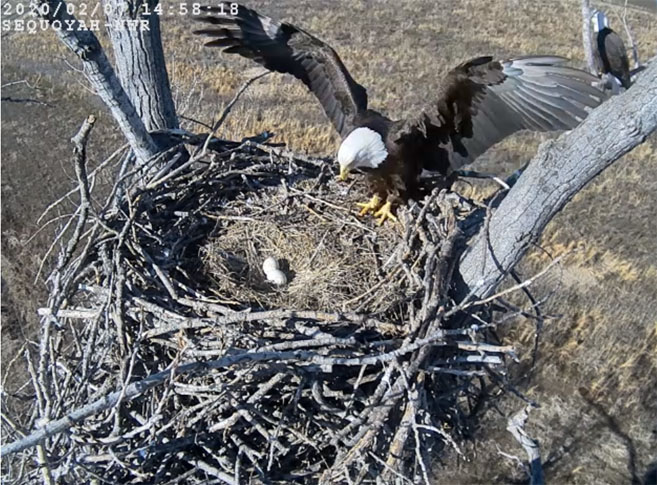
Frosty morning!

5 February 2020: It looks like the first egg has pipped! This is right on time for the expected hatch date of February 6 or 7
for the first egg. The process of hatching in eagles can take up to 2 days. It is a lot of tiring work to break out of that shell!
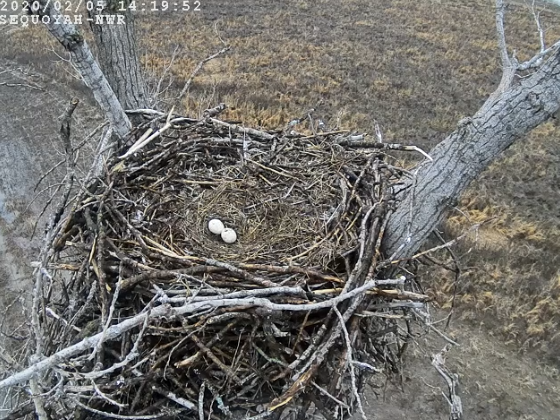
3 February 2020: Incubation must be easier on February days like this when the temperature reaches 70 degrees F!

29 January 2020: A flock of Red-winged Blackbirds passes by the nest while the eagles take a brief break from incubation.
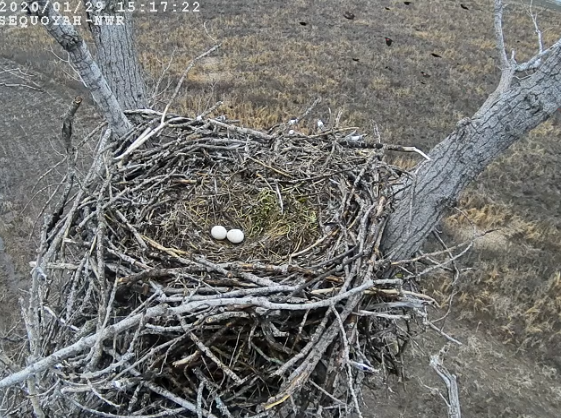
23 January 2020: The eagle pair roosting with heads tucked after sunset.

7 January 2020: A second egg was laid today!

4 January 2020: The first egg was laid this afternoon!

Nest Updates for the 2019 season:
28 May 2019: The internet connection at the refuge seems to be struggling today, but the chick is still there and significant flooding is visible below the nest.

2 May 2019: As viewers have seen, the eaglet is occasionally out of sight of the camera now as it prepares to leave the nest for good. It may occasionally return in the next few weeks, but also don’t be surprised if it leaves soon and isn’t seen again on camera. This is normal.
26 April 2019: The eaglet has been branching recently, as shown here. This period of exploration outside of the nest precedes fledging.

24 April 2019: The egg is gone, after being seen with a hole in it last week (see April 16 photo below).


16 April 2019: The eaglet is exercising its wings regularly in preparation for leaving the nest within the next few weeks.

2 April 2019: Stretching feels good!

1 April 2019: A little bit of gray down is still present on the chick along its back, as visible here, but the dark brown juvenile feathering is now almost complete.


27 March 2019: A subadult eagle landed on the nest and began eating leftover food. Before long, one of the adults flew in to aggressively displace the intruder!

13 March 2019: It is a wet day at the nest!

11 March 2019: More and more feathers are appearing as dark blobs within the chick’s coat of gray down.

4 March 2019: Feed me! The chick has grown substantially in the past week, and can spend a little more time uncovered, even with the chilly weather.

26 February 2019: An adult returns to the nest after a short break away.

21 February 2019: While the majority of time is spent brooding the young chick at this stage of the nesting cycle, the chick is fed a number of times each day, which provides good viewing opportunities.

18 February 2019: Feeding time at the nest.

10 February 2019: The new arrival has more fish than it can eat for quite some time!


8 February 2019: While the first egg has likely failed, it looks like the second has been pipped! And food is arriving!



7 February 2019: Still two eggs!

6 February 2019: Still two eggs!

5 February 2019: Waiting for the first egg to hatch!


29 January 2019: All appears well at the nest, with incubation of two eggs continuing.

25 January 2018: Nighttime incubation and roosting on a nearby branch.

18 January 2019: Another mild day at the eagle nest, but it is about to turn colder tomorrow.


16 January 2018: After a short break, an eagle returns to resume incubation.

15 January 2019: Here is an action shot of one adult leaving while the other takes over incubation.

14 January 2019: Incubation of two eggs continues. One picture shows both adults at the nest, while the other shows one bird preening after taking over incubation duties while the second bird flies off to a nearby branch for a break.


7 January 2019: A second egg was laid the evening of January 6!

4 January 2019: Two adults at the nest with one egg. And a photo of turning the egg for incubation. Bald Eagles begin incubating when the first egg is laid. Any subsequent eggs laid a few days apart then hatch at later dates than the first egg, and the chicks will be slightly different ages and sizes. This incubation strategy differs from some other birds such as quail, which start incubating when their full clutch is complete and all chicks hatch at about the same time.


3 January 2019: The first egg is here (as of yesterday), on a cold and rainy day for incubation!


September 2018: We have replaced the broken camera at Sequoyah NWR in preparation for the 2019 nesting season. Now we are hoping that the eagles decide to use this nest once again! We should know sometime in November or December. Here is a photo from 22 September of an adult at the nest.

